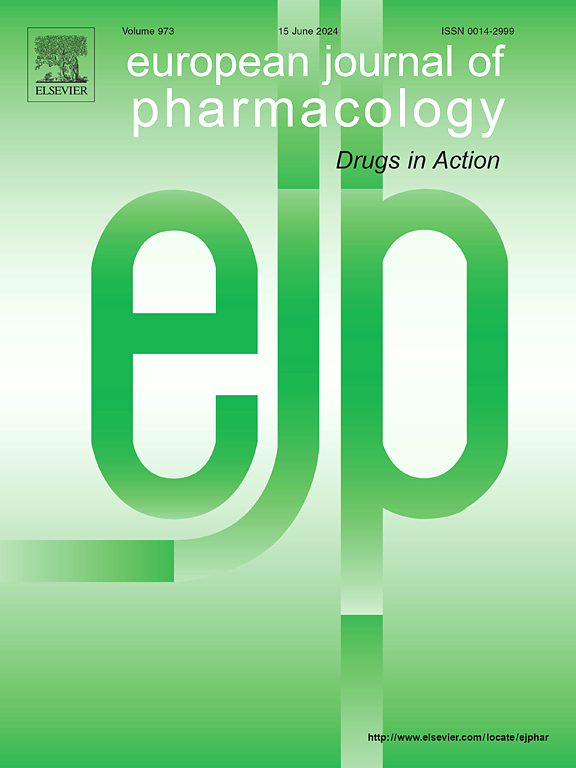CBD, Aβ和内源性大麻素系统酶和受体的体内外串扰。
IF 4.2
3区 医学
Q1 PHARMACOLOGY & PHARMACY
引用次数: 0
摘要
大麻二酚(CBD)是一种从大麻中提取的非精神药物,作为包括阿尔茨海默病(AD)在内的各种神经退行性疾病的潜在治疗剂而受到关注。尽管越来越多的人对此感兴趣,但还需要进一步的研究来阐明CBD影响与AD相关的β-淀粉样蛋白(Aβ)病理积累的具体机制。此外,CBD与内源性大麻素系统(ECS)之间的相互作用,无论是存在还是不存在a β表达,仍然是一个积极研究的主题。阐明这些机制可能为促进我们对神经退行性疾病管理的理解和靶向干预的发展提供有价值的见解。采用多方面的方法,包括药物干预、免疫荧光成像、流式细胞术和生化分析,我们研究了CBD对a β40和a β42的影响。此外,我们分析了大麻素受体1(CB1受体)和脂肪酸酰胺水解酶(FAAH)在存在或不存在Aβ表达的情况下的调节,揭示了CBD复杂的调节机制。我们的发现表明了对CBD的微妙反应;虽然它可能在非病理细胞中产生副作用,但它通过激活微管相关蛋白1轻链3b (LC3B)和Caspase-3途径,在表达a β的细胞中诱导自噬和凋亡。此外,我们对faah-1参与的研究强调了它在表达a β的秀丽隐杆线虫(C. C.)中减轻咽功能障碍和抵消体重减轻的作用。线虫)菌株。这些见解促进了我们对CBD在解决神经退行性病理方面的治疗潜力的理解。本文章由计算机程序翻译,如有差异,请以英文原文为准。
In vivo and In vitro Crosstalk Among CBD, Aβ, and endocannabinoid system enzymes and receptors
Cannabidiol (CBD), a non-psychotropic compound derived from Cannabis sativa, has garnered attention as a potential therapeutic agent for various neurodegenerative diseases, including Alzheimer's disease (AD). Despite growing interest, additional research is required to clarify the specific mechanisms by which CBD influences the pathological accumulation of β-amyloid (Aβ) associated with AD. Moreover, the interactions between CBD and the endocannabinoid system (ECS), both in the presence and absence of Aβ expression, remain a subject of active investigation. Elucidating these mechanisms may provide valuable insights for advancing both our understanding and the development of targeted interventions in neurodegenerative disease management.
Using a multifaceted approach that integrates pharmacological interventions, immunofluorescence imaging, flow cytometry, and biochemical assays, we examined the effects of CBD on Aβ40 and Aβ42. Additionally, we analyzed the modulation of cannabinoid receptor 1(CB1 receptor) and fatty acid amide hydrolase (FAAH) in the presence or absence of Aβ expression, uncovering the intricate regulatory mechanisms of CBD. Our findings indicate a nuanced response to CBD; while it may produce side effects in non-pathological cells, it demonstrates an ability to induce autophagy and apoptosis in Aβ-expressing cells via the activation of the Microtubule-associated protein 1 light chain 3 B(LC3B) and Caspase-3 pathways. Furthermore, our investigation into faah-1 involvement highlighted its role in alleviating pharyngeal dysfunction and counteracting weight loss in Aβ-expressing Caenorhabditis elegans(C. elegans) strains. These insights advance our understanding of CBD's therapeutic potential in addressing neurodegenerative pathologies.
求助全文
通过发布文献求助,成功后即可免费获取论文全文。
去求助
来源期刊
CiteScore
9.00
自引率
0.00%
发文量
572
审稿时长
34 days
期刊介绍:
The European Journal of Pharmacology publishes research papers covering all aspects of experimental pharmacology with focus on the mechanism of action of structurally identified compounds affecting biological systems.
The scope includes:
Behavioural pharmacology
Neuropharmacology and analgesia
Cardiovascular pharmacology
Pulmonary, gastrointestinal and urogenital pharmacology
Endocrine pharmacology
Immunopharmacology and inflammation
Molecular and cellular pharmacology
Regenerative pharmacology
Biologicals and biotherapeutics
Translational pharmacology
Nutriceutical pharmacology.

 求助内容:
求助内容: 应助结果提醒方式:
应助结果提醒方式:


